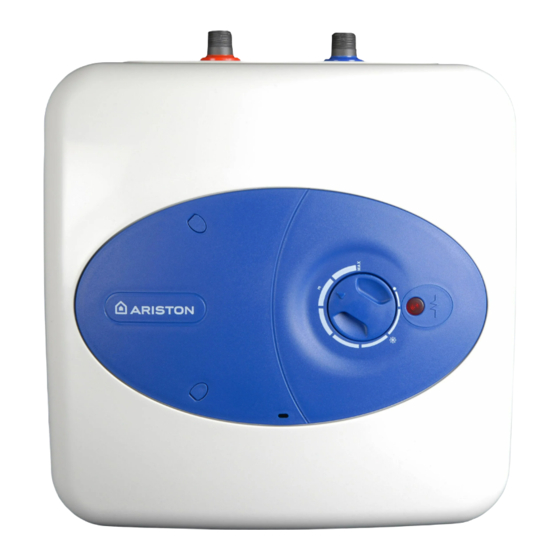Ariston EP 10 UR 3KW Manual - Página 8
Navegue en línea o descargue pdf Manual para Calentador de agua Ariston EP 10 UR 3KW. Ariston EP 10 UR 3KW 17 páginas. Unvented water heater

6
The EP 30 R 3KW is covered under the Building Regulations and therefore
it is not possible to accommodate the expansion water within the system
pipe work and consequently a set of expansion controls must be installed.
Note: The discharge from relief valves must be made in a safe and
conspicuous manner; therefore a tundish (Kit C) is available for 10 and 15
litre units if required.
Please note that in all cases the dielectric junctions must be
connected to the heater before any other connection is made (these
prevent an electrolytic reaction).
Only the use of copper pipe is recommended for connection to the
heater. If any other material is used it must be able to withstand 90°C
at 7 bar pressure for long periods.
No valve must be fitted between the expansion/pressure relief valve
and the water heater.
c) DISCHARGE PIPE WORK
NOTE:
1) The tundish must be vertical and fitted within 500 mm of the temperature
& pressure relief valve and must be located with the cylinder. The tundish
must also be in a position visible to the occupants, and positioned away
from any electrical devices. The discharge pipe from the tundish should
terminate in a safe place where there is no risk to persons in the vicinity of
the discharge and to be of metal.
2) Discharge pipes from the temperature & pressure relief and pressure
relief valve may be joined together.
3) The pipe diameter must be at least one pipe size larger than the nominal
outlet size of the safety device unless it's total equivalent hydraulic
resistance exceeds that of a straight pipe 9 m long.
i.e. Discharge pipes between 9 m and 18 m equivalent resistance length
should be at least 2 sizes larger than the nominal outlet size of the safety
device. Between 18 m and 27 m at least 3 times larger, and so on.
Bends must be taken into account in calculating the flow resistance.
See fig..5 and Table 2.
4) The discharge pipe must have a vertical section of pipe at least 300 mm
in length, below the tundish before any elbows or bends in the pipe work.
5) The discharge pipe must be installed with a continuous fall.
6) The discharge must be visible at both the tundish and the final point of
discharge, but where this is not possible or practically difficult; there should
The following guidelines refer to Building
Regulation G3. It is good practice to follow these
guidlines for all relief valve discharge pipe work.
